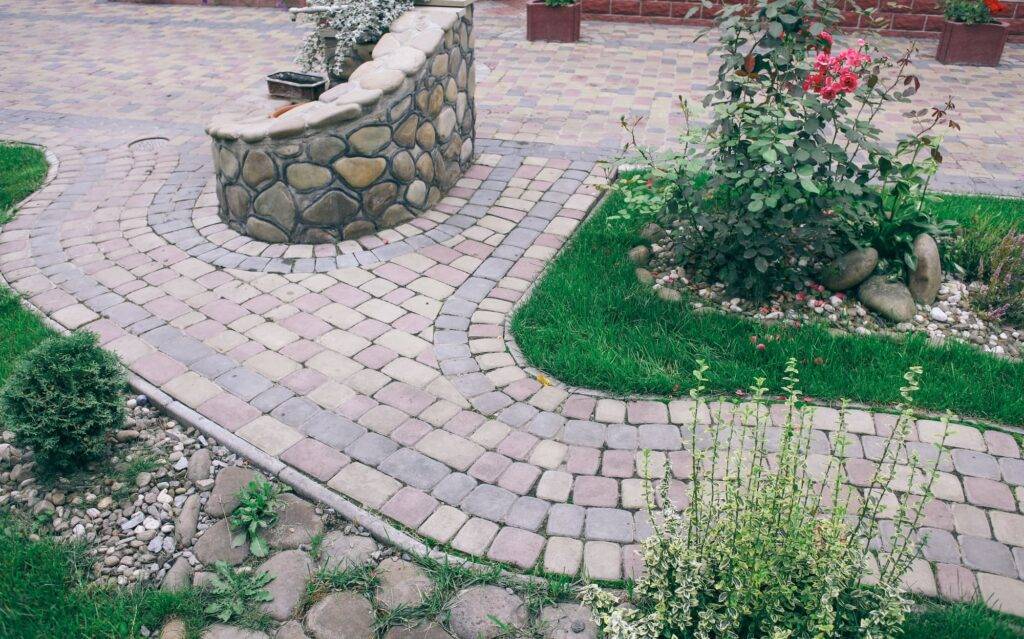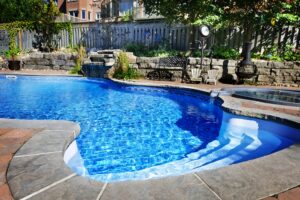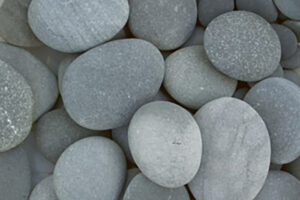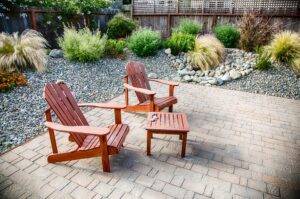Updated August 2023
Understanding Pavers vs Flagstone
Both flagstone and pavers are popular choices for hardscape design, each with specific benefits.
- Flagstone is a natural stone frequently used for walkways by people who want a natural or rustic hardscape look.
- Pavers are a manufactured alternative that works well if you prefer a uniform design.
- When deciding between flagstone vs. pavers, it helps to consider your budget, project’s purpose, and personal style.
Modern landscape design often involves installing new hardscape elements that complement the style and layout of the yard. When planning a hardscape project, you have many options that are both highly functional and aesthetically pleasing. In place of the overuse of concrete that was previously popular, many modern designs utilize natural stone or fabricated pavers for walkways and patios. Homeowners often have difficulty deciding whether flagstone or pavers make more sense for the space. By learning more about each type of hardscape material, you can decide which one makes the most sense for your project.
See also: What’s the difference between polished and unpolished beach pebbles?
What IS Flagstone?
You probably picture flat, roughly cut stone scattered down a walkway or used as a landscape border when you think of flagstone. Flagstone actually encompasses several different types of stone used for hardscape projects, including slate, bluestone, limestone, travertine, and other types of naturally sourced stone. Many homeowners prefer the look of natural stone over uniform pavers because it results in a more freeform, organic design. Some types of natural stone are also considered luxury items, which is appealing for homeowners seeking an upscale result.
Flagstone Sourcing
Since natural flagstone is not manufactured, it must be collected from a quarry source. Since each type of stone naturally has a different look and feel, your style and preferences determine which type you should consider. The stone used for flagstone hardscape projects is sourced from many locations throughout the country and the world. The type of flagstone you use can also impact your budget. The rarer types or certain color variations may cost more than those that are easy to find and are a common color.
Flagstone Installation Options
Choosing the right stone for your project is only part of the decision-making process. Deciding how you want it installed on your property is another key element in the overall design. Flagstone can be placed in the grass, and the grass can grow between to make a natural walkway. Alternatively, the hardscape installer can clear the space for the pathway or patio, fill it with an underlayment material, and arrange the flagstones in a way that creates a cohesive design. The pieces can then be mortared together, or the joints can be filled with pea gravel to solidify the area. Depending on the look you seek, the flagstone can contrast with the joints or present with a subtle difference.
WHAT IS A Paver?
Like natural stone, pavers come in a variety of colors and shapes. Unlike natural stone, pavers are uniformly constructed. This means you can piece pavers together to create a streamlined and uniform look without having to worry about arranging each one in a certain direction to fit the space. Some pavers are created to mimic the look of natural stone, while others resemble brick or cobblestone.
Types of Pavers
Pavers can be used for driveways, walkways, patios, decks, and firepits. They can be distinguished by the material used in construction and the shape of the paver itself. Although natural stone is sometimes used for the same purpose as a paver, the difference lies in the sourcing. In this discussion, pavers are manufactured instead of quarried.
- Clay and brick pavers. Often used interchangeably, brick and clay pavers have been in use for hundreds of years. They are formed by molding the clay and then baking to create a solid piece. For hardscaping, they are placed on sand or mortared together.
- Concrete. The most popular paver choice, concrete pavers, come in a wide range of colors and sizes for your project. With a concrete paver, you get the strength of concrete while still yielding a more upscale look than a poured concrete slab.
- Rubber or plastic. The least realistic paver types, entirely faux pavers constructed from rubber or plastic, are popular for those looking to complete hardscaping on a strict budget. These are commonly placed over existing concrete slabs for a new look.
- Square and rectangle pavers. The look of traditional brick can be achieved with a rectangular paver of a similar size. Rectangle and square pavers continue to be some of the most popular choices because they are easy to lay and reduce installation time without sacrificing the aesthetic.
- Interlocking. Pavers that are shaped in a way that makes them interlock when installed are desirable because they allow an installation that doesn’t involve mortar in between. Interlocking pavers result in a strong patio or walkway and provide an attractive pattern.
- Curved. Pavers shaped with curved edges allow the construction of a freeform or curved walkway or patio. They can be used around the edge only or as part of an integrated firepit.
Paver Installation Options
Depending on your finished patio or walkway project’s desired look, there are several paver installation options. To provide an even and uniform look, the area must be cleared, and a layer of sand or other stabilizing material is first spread evenly. The pavers are placed on top of this layer and wedged tightly together. Professional paver installers use specialized tools to keep the pavers level during installation. A special type of sand that contains silica particles secures the pavers in place.
In some cases, a special paver or installation process is necessary to make the patio or walkway more permeable to water. Many areas have stormwater regulations that require special pavers. In these cases, additional draining layers are required under the pavers, and the small spaces between the pavers must allow drainage.
HOW TO KNOW IF YOU Should Use Flagstone Or Pavers?
If you have a pavers vs flagstone dilemma, ask yourself a few questions to help you decide which material and style is right for your project. What is your budget? Flagstone is generally more costly than pavers, but the material is natural stone. Do you prefer a freeform and organic look to your landscape or a more streamlined and uniform view? Are there any installation restrictions on your property? When it comes to your final hardscape decision, your ideal aesthetic is usually the deciding factor. If you still have trouble deciding between flagstone, pavers, or other hardscape elements, call us today speak with a professional designer for advice about how to bring your vision to life.
Create Your Perfect Hardscape
No matter where you are in your project planning process, the team at Epic Stoneworks is here to help you create the space of your dreams. From a natural, organic outdoor sanctuary to a clean and modern entertainment area, adding a walkway, patio, or other stonework structure can transform the entire look of your property. To learn more about flagstone, pavers, or other hardscaping materials or to schedule an appointment to discover your options, contact Epic Stoneworks today to get started. Questions? Call 305-493-8562
Featured Image: Vladimir Trynkalo/Shutterstock



